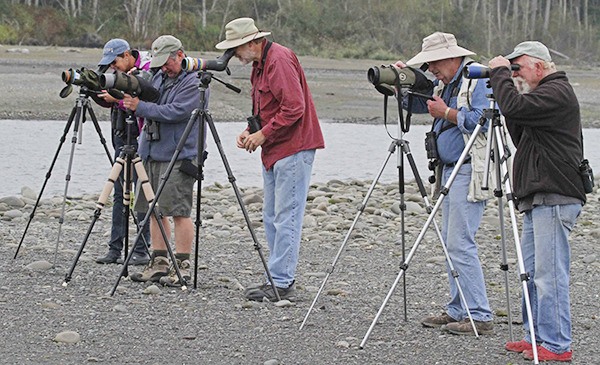Nature is ever-changing and birds are no exception.
Observed changes among local bird populations have been recorded for the past 40 years by members and volunteers of the Olympic Peninsula Audubon Society (OPAS) during the annual Christmas Bird Count.
“It’s perhaps the longest running timeline study that has been done on organisms in the Sequim-Dungeness area,” Bob Boekelheide, OPAS vice president and bird count organizer, said. “There’s some very interesting data that has popped up over the years.”
Among the data have emerged some noticeable trends, including a general decline in the number of seabirds, such as western grebes, white-winged scoters and common loons.
The number of western grebes recorded has continued to dwindle. The greatest to be recorded was 533, but most recently only 47 were counted.
“The trend-line of the western grebe is mirrored by a lot of the water bird species,” Ken Wiersema, OPAS president, said.
Many factors, ranging from conservation, hunting and habitat loss to changes in food availability, can impact bird populations and cause species to uniquely respond, but Wiersema and Boekelheide both agree climate change is likely among the factors, too.
Data collection
To separate trends from mere dips and spikes among bird species, Wiersema and Boekelheide rely on bird counts.
“You always have to be careful with bird data because there’s so many variables involved,” Boekelheide said. “You really have to look at the long-term trends.”
Through OPAS, the local chapter of the National Audubon Society and Dungeness River Audubon Center partner, birders annually document each species present and count the number of individuals. The Christmas Bird Count is done on a single day between mid-December and early January. Using shared methods, the counts are done nationally among Audubon chapters.
“Accuracy is a concern and that’s true with any citizen science, but we do our best,” Boekelheide said.
Boekelheide also conducts the USGS-supported annual Breeding Bird Survey done mid-June.
“We time it so you’re getting almost entirely nesting birds in your locality,” he said.
The Breeding Bird Survey is conducted along a 25-mile route — one that Boekelheide has done for two decades.
In partnership with the Cornell Laboratory of Ornithology, the locally derived data is included into larger databases available for further analysis. Information gleaned from the databases can then be used to inform policy, guide conservation efforts, increase awareness of species distribution and population trends and potentially indicate other phenomena underway, like shifts in seasons, Wiersema explained.
Citizen science is a powerful tool because “birds are our most visible form of wildlife,” he said. “Consequently, you have a lot more potential for observing their reaction and changes to the climate,” he said.
Observed changes
The timing and temperature of the seasons can influence birds.
“I think we are seeing an advancement of seasons,” Boekelheide noted.
In response, he said, both migration and nesting is happening earlier. “It’s hard to track these things because it’s just this general creep, but if you look over a longer period of time, the trend-line is definitely in that direction.”
Some waterfowl species, like golden eyes and buffleheads that migrate south to winter, won’t move in large numbers until they experience a “good cold snap,” Boekelheide said.
“So, for example, we’ll start seeing bigger numbers here usually after a big freezing spell in the Gulf of Alaska,” he said. “That might happen in October, but if that cold weather never happens or if it’s late, then migration south doesn’t happen or the birds stay farther north during the winter time.”
Drought conditions, like those experienced statewide last summer can impact bird behavior and numbers, too.
“Most research shows songbirds poorly nesting in drought years,” Boekelheide said. “Insect populations are low, the nesting season is restricted and therefore they’re less likely to lay second or third clutches.”
Yet, the number of species recorded during the Sequim-Dungeness Christmas Bird Count is going up. Boekelheide said the increase is partly because of introduced species, like the successful Eurasian collared-doves as well as more birds staying farther north during the winter.
“We’re in a spot here in coastal Washington where we’ll probably see an increase in species during the winter, but the species that are doing that are land birds,” he said. “This year (2015 CBC) we had a lot of land birds that did very well, so things like sparrows and woodpeckers had high counts.”
OPAS set a state record for number of species recorded during the 2015 Christmas Bird Count with 154 species. Seventeen landbird species hit all-time high counts.
However, the trend for water birds remains a “general downward decline” Boekelheide said.
Like the decline of western grebes, the white-winged scoter has dropped from a high of 1,374 to a record low of 36 recorded during the 2015 Christmas Bird Count. The 20-year average of the white-winged scoters is 268.
Whether the emerging trends in locally documented bird species is related to climate change or perhaps “the general systemic degradation of the Salish Sea and disappearance of forage fish” isn’t clear, Boekelheide said.
“For our local birds there are much bigger issues for water birds than there are for land birds,” he said. “The same things that are effecting other marine life, like salmon and orcas, also seems to also be affecting our water birds.”
Although there’s no one answer as to what is causing some bird species to locally decline and others to increase, nor what those changes mean, “the main thing is we need to be sensitized to it,” Wiersema said. “Birds offer us that venue to hone our observations of what’s going on because we can see it reflected in their behaviors.”
To learn more about OPAS or to report bird sightings, contact Wiersema at 683-4763 or visit olympicpeninsulaaudubon.org.



